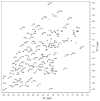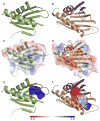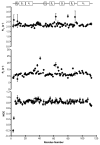NMR Structure of Francisella tularensis Virulence Determinant Reveals Structural Homology to Bet v1 Allergen Proteins
- PMID: 26004443
- PMCID: PMC4835214
- DOI: 10.1016/j.str.2015.03.025
NMR Structure of Francisella tularensis Virulence Determinant Reveals Structural Homology to Bet v1 Allergen Proteins
Abstract
Tularemia is a potentially fatal bacterial infection caused by Francisella tularensis, and is endemic to North America and many parts of northern Europe and Asia. The outer membrane lipoprotein, Flpp3, has been identified as a virulence determinant as well as a potential subunit template for vaccine development. Here we present the first structure for the soluble domain of Flpp3 from the highly infectious Type A SCHU S4 strain, derived through high-resolution solution nuclear magnetic resonance (NMR) spectroscopy; the first structure of a lipoprotein from the genus Francisella. The Flpp3 structure demonstrates a globular protein with an electrostatically polarized surface containing an internal cavity-a putative binding site based on the structurally homologous Bet v1 protein family of allergens. NMR-based relaxation studies suggest loop regions that potentially modulate access to the internal cavity. The Flpp3 structure may add to the understanding of F. tularensis virulence and contribute to the development of effective vaccines.
Copyright © 2015 Elsevier Ltd. All rights reserved.
Figures




References
-
- Bhattacharya A, Tejero R, Montelione GT. Evaluating protein structures determined by structural genomics consortia. Proteins. 2007;66:778–795. - PubMed
-
- Bieri M, d’Auvergne EJ, Gooley PR. relaxGUI: a new software for fast and simple NMR relaxation data analysis and calculation of ps-ns and mu s motion of proteins. J Biomol NMR. 2011;50:147–155. - PubMed
Publication types
MeSH terms
Substances
Associated data
- Actions
Grants and funding
LinkOut - more resources
Full Text Sources
Other Literature Sources

